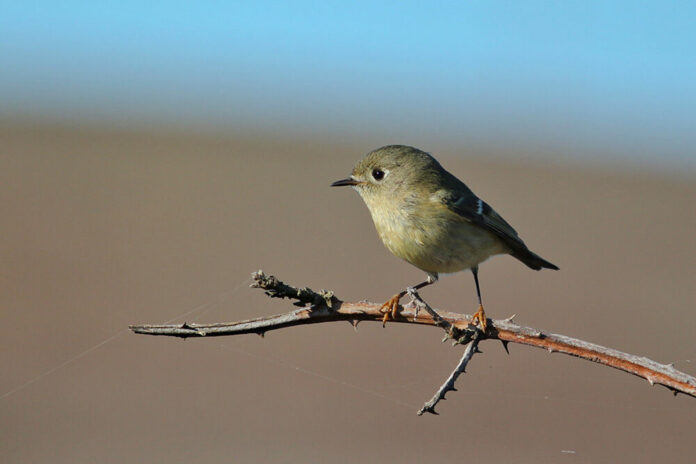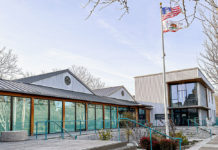Local birders bring down the house with online lecture on beginning birding
On Jan. 28, Guerneville-based birding experts Miles and Teresa Tuffli gave a lecture called “Breaking into Birdwatching” as a part of the Laguna Foundation series, “Birding to Beat the Winter Blues.”
The Tufflis give guided bird walks and teach beginning birding classes in Sonoma and Marin counties. Their website and blog, called “I’m Birding Right Now” is a record of their local birding adventures.
“I would think it’s safe to say that Teresa and I are both quite obsessed with birds,” Miles said.
The Tufflis started birding after they got together as a couple.
“The very first time we went out bird watching, we realize how amazing it made us feel and just kept coming back day after day and really haven’t stopped since,” Miles said.
“The physical and mental act of going out birdwatching hooked us right from the start with just how amazing it made us feel while we were doing it and even afterwards,” he said. “First off, it gets us outside, which is really important, but it also encourages us to slow down and engage our senses in the natural world, which has a number of wonderful benefits. And we really appreciate how it keeps us grounded in the moment.”
The Tufflis’ lecture was jam-packed with information, covering everything from the best types of binoculars for beginning birders (8×42); how to use binoculars (keep your eyes on the bird and raise the binoculars to your face without looking away from the bird); where, when and how to find birds to watch, and finally, how to identify birds once you spot them.
This article will cover just one small part of their lecture called “How to look at a bird.”
“I know when we first started getting interested in bird watching, an unfamiliar bird would pop up and we would be overwhelmed with what to look at in order to identify it. First we’d try to get it in our binoculars and then there’d be so many different things to look at, and it would fly away after five or 10 seconds. We were trying to look at everything at once, and so we ended up often not really noticing anything very helpful,” Miles said.
As a result, they adopted a systematic approach on “how to look at an unfamiliar bird, in order to try to narrow it down to maybe at least a family of birds or hopefully, an actual individual species.”
Look at the bill
“Notice everything you can about the bill: the size of it, the shape, the color, any other details,” Teresa said, noting that for size, “you can always measure the bill size compared to the head of the bird itself: is it about the same length as the head? Or is it a lot shorter? Or is it longer?”
“Once you can start identifying the different types of bills, you’ll notice that they often will indicate what kind of food the bird eats. That in turn can help give you an idea of where that bird might be found and what kind of habitat or vegetation that it likes to be in. So there’s a lot of information that can be gleaned from the bill,” she said.
Look at the size of the bird
The Tufflis say the next thing to notice is the size of the bird, which is tricky because you’re often looking at the bird from a distance or even flying. If it’s sitting still, you can always try comparing it to what it’s sitting next to, but the Tufflis also suggest comparing it in your mind to other familiar birds.
“One helpful tip we like to give is to use benchmark birds that you’re already familiar with,” Miles said, showing a slide of familiar birds ranging from sparrow to robin to crow to goose. “So when you see an unfamiliar bird pop up, visualize it somewhere on the spectrum of your familiar benchmark birds.”
Look at the bird’s silhouette
Looking at creatures as complicated and varied as birds, it’s easy to lose sight of some obvious structural details. That’s why the Tufflis suggest focusing first on the bird’s silhouette.
“When we try to assess the shape of a bird out in the field, we like to imagine it in silhouette, because it helps us focus on the proportions instead of getting distracted by the color or the patterns,” Teresa said.
Imagining the silhouette of the bird lets you easily pick up on distinctive features, like its posture (is it more vertical or horizontal?), the length of its legs, the angle of its tail or head shape (round or tufted, for example).
Look at the “field marks”
Like all niche pastimes, bird watching has a lingo all its own, which is especially true when it comes to the question of field marks.
According to Teresa, “A field mark is simply a visible mark that you can see while you’re out birdwatching that helps you identify a bird in the field.”
These can include vertical marks known as streaking; horizontal marks known as barring; patches of color; color blocking such as a different colored head, breast or wing patch; wing bars; as well as striping and spotting.
The Tufflis noted that birds’ faces are often particularly rich in field marks, ranging from eye color to eyebrows, eyerings (a different color of feather encircling the eye), or eye-stripes (color stripes that intersect the eye).
Teresa joked that one of Sonoma County’s commonly seen birds, the Northern Flicker “looks like it fell out of the field mark tree and hit every branch on the way down. It’s just littered with field marks.”
Look at a bird’s behavior and surroundings
To increase your chance of identifying a bird correctly, the Tufflis suggest you ask yourself questions about its behavior like, “Where is the bird located? What is it doing? Is it perched or moving, alone or in a flock?”
They also suggested that you pan back and take a look at the bird’s environment: is it on the ground, in a tree (perched on a branch or clinging to the trunk), at the seashore, etc.
Hit the books
Once you’ve answered some of these questions, you’ve got a good chance of being able to identify the bird in a bird book. The Tufflis recommended several books, including the “Sibley Field Guide to the Birds of North America.”
To finish off their presentation, the Tufflis also explored identifying birds by sound (songs and calls are different things, who knew?), how to use a field guide, where to find birding resources and more.
It was a tour de force performance.
In addition to local would-be birders, the webinar attracted a national and international audience. If the attendees could have brought the house down with thunderous applause they would have, but since this was a virtual experience they had to settle for bombarding the chat box with bravas and applause emojis.
See the Tufflis’ website and blog at https://imbirdingrightnow.com/
The next lecture in the “Birding to Beat the Winter Blues” series is a bilingual (English/Spanish) program called “Migration: How Birds Connect the World,” on Feb. 4 at 4 p.m. Register here: https://www.eventbrite.com/e/migracion-como-conectan-el-mundo-los-pajaros-registration-132876361775








